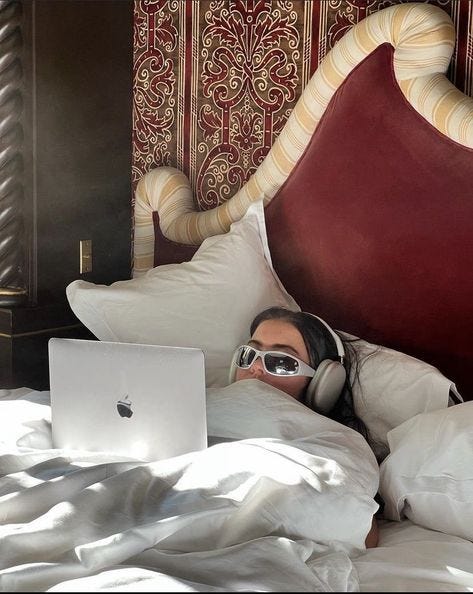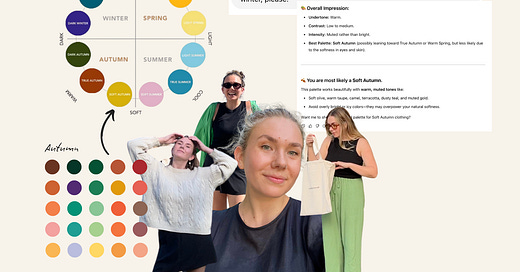My colour analysis made me want to throw out all my clothes
Plus, how you can figure out what colours suit you using AI
Colour analysis is one of those things I’d always been vaguely aware of but never really engaged with.
Until a few months ago, I hadn’t ever put much thought into what colours looked good on me (apart from avoiding red like the plague because my mum once told me it made me look sick — and that’s Dutch honesty for you!).
But it feels like, all of a sudden, colour analysis content is dominating my social media feeds!
If you’ve ever fallen down a TikTok rabbit hole of “What season am I?” videos or spent way too long staring at a colour wheel trying to figure out if you’re a cool or warm undertone, then welcome to the club.
After the hundredth video telling me if I didn’t figure out my colours I’d look like a hideous troll (slight hyperbole), I decided to try to figure it out for myself. The results have left me with very mixed feelings…
What is colour analysis?
If you’ve never head of “getting your colours done” before today, colour analysis is a method used to determine which shades and tones best complement your natural features (like your skin tone, eye colour, and hair colour).
The idea is that wearing the right colours can make you look more vibrant, while the wrong ones can supposedly make you look washed out or dull.
There are different systems, but the most common one categorises people into four seasons — Spring, Summer, Autumn, and Winter — each with its own subcategories.

How did I do it?
I simply do not have the money to pay for a professional colour analyst. However, last year I heard about a way that you could use ChatGPT to perform a colour analysis for you. (Thank you to the Style-ish podcast for the tip!)
How you can use ChatGPT to DIY your colour analysis…*
DISCLAIMER: this is incredibly unscientific! There are so many elements that could influence your AI colour analysis including (but not limited to): the lighting in your selfie, what features you select for your hex code colours and the fact that ChatGPT is not 100% accurate. So use this as a bit of fun and keep your critical thinking hat firmly on your head!
Step 1: Gather Your Colours
Take a Clear Photo – Snap a selfie in natural daylight, without makeup and make sure your features are clearly visible.
Use a Colour Picker – Open the photo in an editing app (I used Canva).
Find Your Hex Codes – Use the colour dropper tool to select your skin, hair, and eye colours, then write down the hex codes.
Step 2: Ask ChatGPT for Your Colour Season
Once you’ve got your hex codes, open ChatGPT and copy-paste this prompt (swapping in your own hex codes):
"My hair is #a49482, #bea88c, #ceb486, my skin tone is #cfa184, #cab0b0, #eaa897, and my eyes are #624e3f, #6f614b, #72664d. Which colour palette am I? In terms of spring, summer, autumn, or winter, please."
Want more details? You can ask follow-up questions like:
What colours suit me best?
What colours should I avoid?
What makeup/jewellery would be flattering?
Step 3: Analyse Your Results
ChatGPT will (hopefully) assign you to one of the four colour seasons — Spring, Summer, Autumn, or Winter — based on your colouring. It’ll also suggest shades that might complement your features and ones that might not be as flattering.
According to my AI-generated analysis, I’m an ‘Autumn’. I should be avoiding icy colours and black (which is unfortunate, because 90% of my clothes are black) and leaning into warm, earthy tones instead.
My first reaction to my results? A mild existential crisis.
*Using AI does have negative environmental impacts. The data centres that power AI require electronics made using rare earth minerals and use thousands of litres of water to cool electrical equipment. However, this is equally true if you use Google or send an email or scroll instagram.
Nothing happens in isolation and everything we do has an impact.
I use AI because it does make my life easier. That’s a choice I’ve made, but I’ve also chosen to curb my environmental impacts in other areas of my life. I have never been, and will never be, a perfect environmentalist. We live in an incredibly imperfect world, so I just want to try my best to be a conscious consumer who makes informed choices. Fingers crossed I can live up to that!

My first thought: panic
My immediate, irrational response to my colour analysis was, “I need to completely update my wardrobe!” Which, let’s be honest, is ridiculous.
It’s giving “micro-trend fast fashion” energy, except instead of cycling through aesthetics, we’re now purging perfectly good clothing from our wardrobes that don’t align with our assigned colour palette.
The thought of people tossing out clothes simply because it doesn’t ‘match’ their season makes me deeply uncomfortable. Overconsumption and waste are two of fashion’s biggest sustainability problems. We really don’t need another excuse to buy more than we need, but it feels like colour analysis is another way to peddle consumerism.
Marketing tells us that you just need to buy one more thing and then your wardrobe will be complete. Except, there will always be one more thing to buy after that, and another thing after that, and on again ad infinitum.
My first instinct after getting ChatGPT to do my colour analysis was to uncritically accept that I now looked terrible in black and if I ever wanted to look fashionable again, I needed to immediately get rid of all of the black clothes in my wardrobe and replace them with shades of brown.
That’s an insane response and luckily I quickly snapped out of it. But, I think this speaks to an inherent desire that fashion marketing has instilled in us — the feeling that buying the right clothes will fix your life. E.g. “If I buy a new wardrobe in my colours, not only would I immediately look more attractive and fashionable, I would also get the job I wanted, my love life would be perfect, I would be invited to fun events etc...” Except, of course, that never happens.
Colour analysis, when taken to the extreme, risks becoming another consumerist trap — fuelling the idea that our current wardrobes are somehow “wrong” and need to be replaced. But throwing out clothes that are still wearable is not the answer.
The best thing we can do for the planet is to wear what we already own. If certain pieces don’t align with our newly discovered colour season, that doesn’t mean they’re wrong. A shift toward mindful consumption — buying with intention, repurposing what we have, and resisting the urge to constantly replace — is far more powerful than simply following another shopping trend.
But… it’s also kinda useful?
That being said, I do think colour analysis can be a helpful tool if used in a balanced way. It can give you a better idea of what makes you feel confident and put-together. Certain colours do have an impact on how we perceive ourselves. I also totally believe that I look better in a brown or a navy than in black. But should we treat our colour season like an unbreakable rule? Absolutely not.
Personal style is personal. If you love a colour, wear it!
For me, I’ll take the colour analysis into account when making future purchases — especially when buying fabric for my sewing projects. But will I stop wearing my beloved all-black outfits? Hard pass. I refuse to be intimidated by a colour wheel!!
How to embrace your colour palette without throwing out all of your clothes
If you do want to incorporate your colour analysis into your wardrobe, you don’t need to overhaul everything and start from scratch. Here are a few ways to refresh your wardrobe in a way that’s sustainable and budget-friendly:
Dye Your Clothes: If you have pieces you love but they’re not in your colour palette, consider dyeing them! Natural fibre garments (like cotton, linen, and silk) take dye beautifully, and it’s a fun way to transform your wardrobe without buying new things.
Clothing Swaps: Organise a clothing swap with friends or your local community. Chances are, someone else has pieces in your palette that they no longer wear and you might have something they love in return.
Sell & Buy Second-Hand: If you really feel like parting with certain items, sell them and use the money to thrift for pieces in your new palette. This way, you’re not contributing to textile waste and you’re extending the lifespan of clothes.
Learn to Sew! One of the best ways to ensure your wardrobe aligns with your preferred colours is to make your own clothes. Choosing fabric in shades that suit you means you get pieces that fit both your palette and your personal style. (If you want to start sewing but don’t know where to begin, check out my guide on how to start sewing!)
At the end of the day, colour analysis should be fun, not restrictive. Use it as a guide, not a rulebook.
And remember, the most sustainable wardrobe is the one you already own!








I love this! I did mine with your instructions and I'm a True Autumn, which makes so much sense. Orange-red is everything to me, and now I know why!
This is such an insightful deep dive and I really loved reading this one! I recently tried one of those apps out of curiosity and was surprised to find I’m a ‘soft summer’ (jury’s still out, to be honest I was convinced I am a “cool winter”). I’m treating it more like a gentle nudge than a hard rulebook. It’s helpful for curbing the ‘buy all the colours!’ instinct, but I’m still going to wear that one rogue orange or black piece I love.